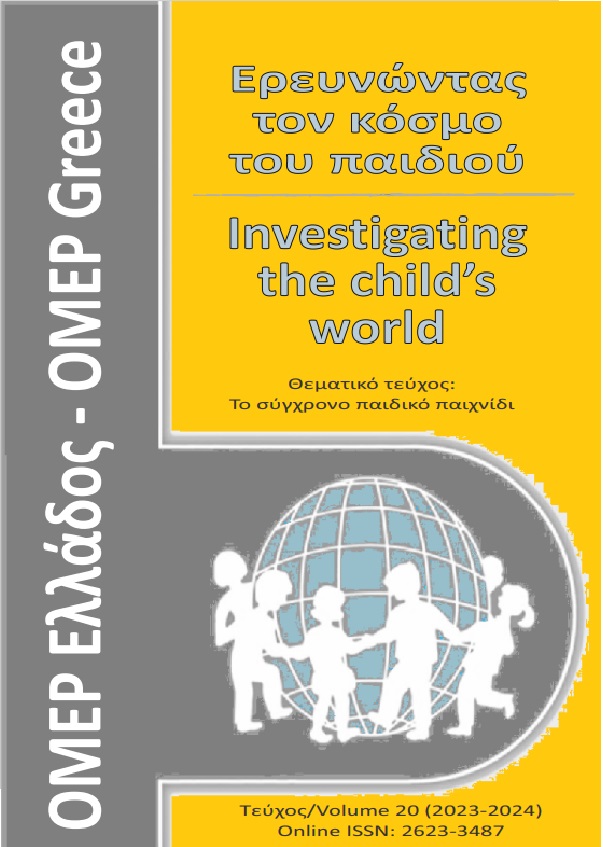Κατανοώντας τη δημιουργική έκφραση των παιδιών στο ελεύθερο μουσικό τους παιχνίδι
Résumé
Οι αυθόρμητες μουσικές συμπεριφορές των παιδιών που αναπτύσσονται στο ελεύθερο παιχνίδι τους, φανερώνουν την πηγαία ικανότητά τους να δημιουργούν ελεύθερα τη δική τους μουσική με δικούς τους όρους και τρόπους. Οι πολύτιμες αυτές μορφές μουσικής έκφρασης περνούν συχνά απαρατήρητες και παραμένουν αναξιοποίητες. Στόχος της παρούσας έρευνας είναι η κατανόηση και ανάδειξη των σημαντικών στιγμών μουσικής έκφρασης των παιδιών κατά τη διάρκεια του ελεύθερου μουσικού τους παιχνιδιού στο νηπιαγωγείο. Η προσέγγιση βασίζεται σε παιδοκεντρικές θεωρήσεις που αναγνωρίζουν την ικανότητα των παιδιών να διαμορφώνουν και να νοηματοδοτούν τις καθημερινές τους εμπειρίες. Τα δεδομένα βασίστηκαν σε παρατήρηση παιδιών από παιδαγωγούς δύο τάξεων δημόσιων νηπιαγωγείων και ενισχύθηκαν με σημειώσεις πεδίου και αναστοχαστικά τους σχόλια. Παιδιά που έπαιζαν μόνα τους ή σε ζεύγη, θεωρήθηκαν ξεχωριστές μελέτες περίπτωσης σε όλη την ερευνητική διαδικασία. Από τη θεματική ανάλυση αναδείχθηκαν στιγμιότυπα και μουσικά τεχνουργήματα που προσδίδουν αξία στην ανεξάρτητη μουσική σκέψη των παιδιών καθώς αυτά ορίζουν και πλαισιώνουν ηχητικά το μουσικό τους παιχνίδι σύμφωνα με τα ενδιαφέροντά τους. Ξεκινώντας από εξερεύνηση διαφορετικών τρόπων παιξίματος, στη συνέχεια προχώρησαν σε μίμηση ή ταίριασμα στο παίξιμο ενός συμπαίκτη. Η δημιουργικότητα κορυφωνόταν με εμπλουτισμό και εναλλαγές ιδεών κατά το μουσικό αυτοσχεδιασμό με το συμπαίκτη. Τα αποτελέσματα αναδεικνύουν την ενεργή συμμετοχή των παιδιών στην οικοδόμηση νοήματος μέσω μουσικών συσχετίσεων με ηχητικές πηγές, συνομήλικους ή τη νηπιαγωγό. Οι παιδαγωγικές και ερευνητικές ενέργειες «παρατηρώ-κατανοώ-αλληλεπιδρώ» φαίνεται ότι ενθαρρύνουν την αλληλεπίδραση στο ελεύθερο μουσικό παιχνίδι των παιδιών. Με την προσεκτική ακρόαση και διακριτική υποστήριξη των παιδιών επιτρέπεται στο αυθόρμητο μουσικό παιχνίδι τους να ξεδιπλωθεί.
Article Details
- Comment citer
-
Δογάνη Κ. (2024). Κατανοώντας τη δημιουργική έκφραση των παιδιών στο ελεύθερο μουσικό τους παιχνίδι. Ερευνώντας τον κόσμο του παιδιού, 20, 105–118. https://doi.org/10.12681/icw.35456
- Rubrique
- Επιστημονική αρθρογραφία & εκπαιδευτικές δράσεις

Ce travail est disponible sous licence Creative Commons Attribution - Pas d’Utilisation Commerciale 4.0 International.
Οι Συγγραφείς που δημοσιεύουν εργασίες τους σε αυτό το περιοδικό συμφωνούν στους παρακάτω όρους:
Οι Συγγραφείς διατηρούν τα Πνευματικά Δικαιώματα και χορηγούν στο περιοδικό το δικαίωμα της πρώτης δημοσίευσης ενώ ταυτόχρονα τα πνευματικά δικαιώματα της εργασίας προστατεύονται σύμφωνα με την Creative Commons Attribution License που επιτρέπει σε τρίτους - αποδέκτες της άδειας να χρησιμοποιούν την εργασία όπως θέλουν με την προϋπόθεση της διατήρησης των διατυπώσεων που προβλέπονται στην άδεια σχετικά με την αναφορά στον αρχικό δημιουργό και την αρχική δημοσίευση σε αυτό το περιοδικό.
Οι Συγγραφείς μπορούν να συνάπτουν ξεχωριστές, και πρόσθετες συμβάσεις και συμφωνίες για την μη αποκλειστική διανομή της εργασίας όπως δημοσιεύτηκε στο περιοδικό αυτό (π.χ. κατάθεση σε ένα ακαδημαϊκό καταθετήριο ή δημοσίευση σε ένα βιβλίο), με την προϋπόθεση της αναγνώρισης και την αναφοράς της πρώτης δημοσίευσης σε αυτό το περιοδικό.
Το περιοδικό επιτρέπει και ενθαρρύνει τους Συγγραφείς να καταθέτουν τις εργασίες τους μέσω διαδικτύου (π.χ. σε ένα ακαδημαϊκό καταθετήριο ή στους προσωπικές τους ιστοσελίδες) πριν και μετά από τις διαδικασίες της δημοσίευσης, καθώς αυτό μπορεί να οδηγήσει σε παραγωγική ανταλλαγή ιδεών και σκέψεων καθώς επίσης και σε γρηγορότερη και μεγαλύτερη χρήση και ευρετηρίαση της δημοσιευμένης εργασίας (See The Effect of Open Access).



